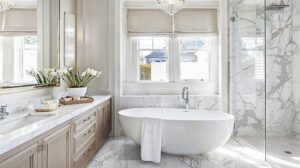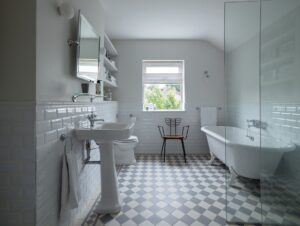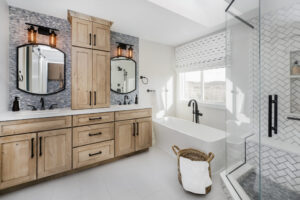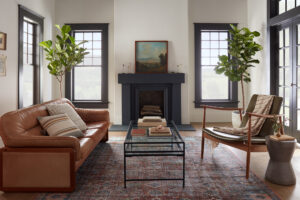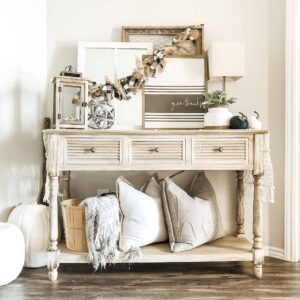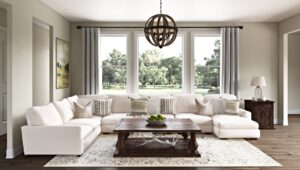Black and White Bathrooms: Timeless Elegance Meets Modern Design
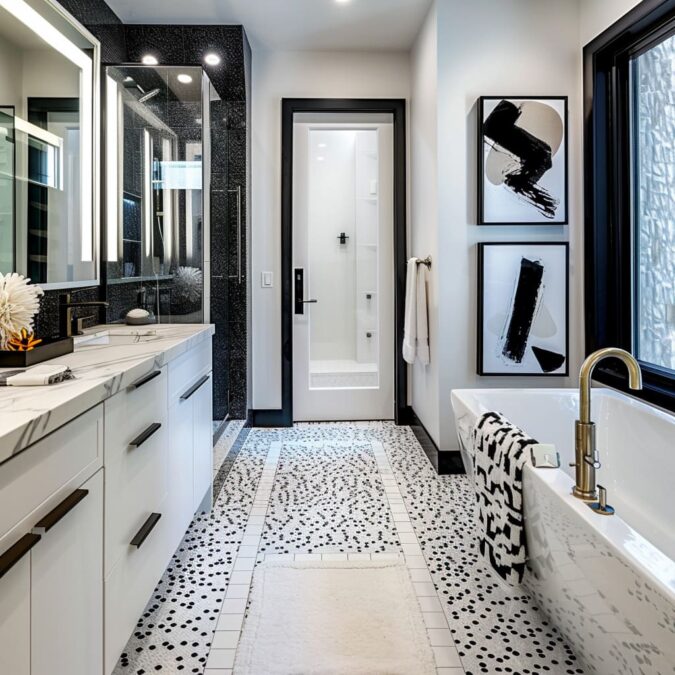
When Sarah and John bought their first home, the bathroom was one of the spaces that needed the most work. It was outdated, cluttered, and filled with flashy, mismatched colors from a bygone era. Determined to create a serene, sophisticated retreat, they knew they wanted something that was both modern and timeless. After hours of scrolling through design inspiration, they settled on a classic but bold color scheme: black and white. The transformation was remarkable as the tiles were laid, and the sleek black fixtures were installed. What was once a chaotic, outdated space became a clean, elegant bathroom with striking contrast and a minimalist design. Every time they stepped into the room, it felt fresh, chic, and calming—the perfect retreat from their busy lives.
Sarah and John’s story familiarizes homeowners looking to renovate their bathrooms. Black and white bathrooms are more than just a design trend; they represent a timeless combination that has endured for decades and continues to evolve with contemporary tastes. Whether your style is classic, modern, or somewhere in between, a black-and-white bathroom can be functional and aesthetically striking. This article will explore why black and white bathrooms remain popular, the different ways to incorporate these colors into bathroom design, the psychology behind the appeal, and the trends driving this enduring style forward.
- The Timeless Appeal of Black and White Bathrooms
a. A Classic Color Combination
Black and white have been a design staple for centuries, representing a balance of opposites—dark and light, bold and understated, classic and contemporary. This timeless color palette has found its way into homes since the early 20th century, particularly in the Art Deco era, where black and white tiles, fixtures, and accents were used to create striking contrasts and geometric patterns.
Due to its versatility, the combination of black and white continues to be favored by designers and homeowners alike. It can be adapted to suit a variety of design styles, from minimalist and modern to vintage and traditional. According to Houzz’s 2022 Bathroom Trends Study, 30% of homeowners who renovated their bathrooms opted for a black-and-white color scheme, reinforcing its lasting appeal across different design preferences.
b. Easy to Pair with Any Style
One of the reasons black and white bathrooms are so popular is their ability to work well with any design aesthetic. Whether you prefer a contemporary spa-like space with clean lines and minimal decoration or a more traditional look with vintage-inspired tiles and clawfoot bathtubs, black and white provides a versatile canvas. In modern homes, black and white are often used to create a sense of sophistication, while in more classic homes, the colors evoke a timeless elegance that never feels out of place.
Even as design trends come and go, black-and-white endures because it serves as a foundation upon which other elements—such as bold fixtures, colorful accents, or textured materials—can be layered. This flexibility is one of the key reasons why black-and-white bathrooms remain a popular choice in both new builds and renovations.
- The Psychology of Black and White: Why It Works
Colors powerfully influence our emotions and perceptions, and the combination of black and white creates a harmonious balance that appeals to many homeowners.
a. The Impact of Black
Black is often associated with sophistication, luxury, and authority. In interior design, it adds a sense of depth and drama to a space. While too much black can feel overwhelming, when used strategically—such as in fixtures, trim, or accents—it can ground a room and give it a refined, polished look. According to Color Psychology, black evokes a sense of control and elegance, making it an ideal choice for creating a sleek, high-end bathroom design. Additionally, black is a color that naturally hides imperfections, making it a practical choice for areas that see heavy use, like countertops or vanities.
b. The Tranquility of White
White, on the other hand, is synonymous with cleanliness, simplicity, and purity. White bathrooms feel fresh and spacious, and white tiles, walls, or fixtures can make even the smallest bathrooms feel open and airy. White reflects light, enhancing the sense of space and cleanliness—an essential quality in bathroom design. According to The Lighting Research Center at Rensselaer Polytechnic Institute, white surfaces reflect up to 80% of the light that hits them, making them ideal for bathrooms that need to feel bright and hygienic.
Together, black and white create a visually striking yet balanced environment, where white’s serenity offsets black drama. This balance makes the bathroom feel luxurious and calming, essential for spaces where people start and end their day.
- Incorporating Black and White into Bathroom Design
Designing a black-and-white bathroom involves more than picking two colors. The key to success is in the details, where combining textures, patterns, and finishes brings the space to life.
a. Flooring and Wall Tiles
Tiles are one of the most effective ways to incorporate black and white into a bathroom design. Black and white floor tiles, especially in geometric patterns, are a popular choice that dates back to the early 1900s. Patterns like hexagons, herringbone, and chevrons are all classic ways to use black and white tiles that add texture and visual interest.
In modern homes, large-format white tiles can create a clean, minimal look, while black tiles can be used as a bold contrast. According to HomeAdvisor, tile installation is one of the most common elements in bathroom renovations, and 42% of homeowners opt for black or white tiles in their bathrooms. White subway tiles are a classic option for shower walls or backsplashes, while black tiles can be used in specific areas to create a statement wall or an accent.
b. Fixtures and Hardware
One of the easiest ways to introduce black into a bathroom is through fixtures and hardware. Matte black faucets, showerheads, towel bars, and cabinet pulls are sleek and modern, adding just the right amount of contrast against white countertops, vanities, or tiles. Black fixtures have grown in popularity in recent years, with a Remodeling Magazine report indicating that matte black hardware is now one of the top trends in bathroom design, especially for those looking to add a modern or industrial touch.
White fixtures—freestanding bathtubs, sinks, and toilets—are timeless and blend seamlessly with black accents, ensuring the overall look remains balanced. Homeowners can also incorporate metallic accents like chrome, brass, or gold for glamour and contrast, provided the bathroom doesn’t feel too stark or monochromatic.
c. Mixing Materials and Textures
Mixing materials and textures is key to preventing a black-and-white bathroom from feeling too cold or sterile. For instance, pairing glossy white tiles with matte black cabinetry can create a sense of contrast and depth. Natural materials like wood or marble can also soften the starkness of black-and-white, bringing warmth and texture into the space. A marble countertop with subtle veining or wooden shelves can introduce organic elements that balance the boldness of the color palette.
- Modern Trends in Black and White Bathrooms
Black-and-white bathrooms have evolved to keep up with modern design trends. Today, the focus is on creating spaces that feel both luxurious and personal, using a mix of textures, materials, and finishes to add depth and interest.
a. Statement Bathtubs and Showers
One of the growing trends in bathroom design is the use of statement bathtubs or showers as focal points. In black-and-white bathrooms, a freestanding white tub against a black tiled wall can create a dramatic yet sophisticated look. Alternatively, an all-white shower with black fixtures and trim provides a sleek, minimalist contrast.
b. Industrial Influence
The industrial design trend has been making waves in the bathroom world, and black-and-white color schemes fit seamlessly into this aesthetic. Exposed plumbing, metal-framed shower doors, and matte black fixtures all contribute to a contemporary and functional industrial vibe. Pairing black fixtures with natural stone or concrete materials enhances the industrial feel while maintaining a sense of warmth.
- Budgeting for a Black and White Bathroom Remodel
While black and white bathrooms can create a high-end look, the cost of a remodel depends mainly on the materials and finishes chosen. HomeAdvisor says the average price of a bathroom remodel ranges from $10,000 to $25,000, with materials like tile, cabinetry, and fixtures accounting for a significant portion of the budget. However, black-and-white designs can be achieved at various price points. For instance, while marble or high-end tiles may be more expensive, there are affordable ceramic or porcelain alternatives that mimic the look of luxury materials.
Homeowners looking to refresh their bathroom on a budget can focus on minor updates, such as swapping out hardware for black fixtures, repainting cabinetry, or adding a new black-framed mirror to create a bold visual impact without breaking the bank.
Conclusion: A Color Palette That Never Goes Out of Style
Black and white bathrooms remain a design staple for good reason. Their timeless appeal, versatility, and ability to adapt to any style make them popular for homeowners seeking both functionality and elegance. Whether you want to create a minimalist retreat or a bold, dramatic space, black and white offers a sophisticated foundation you can build. As trends in bathroom design continue to evolve, the classic black-and-white palette remains a constant, proving that sometimes, the simplest combinations are the most enduring.

